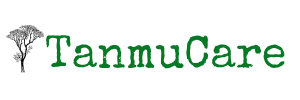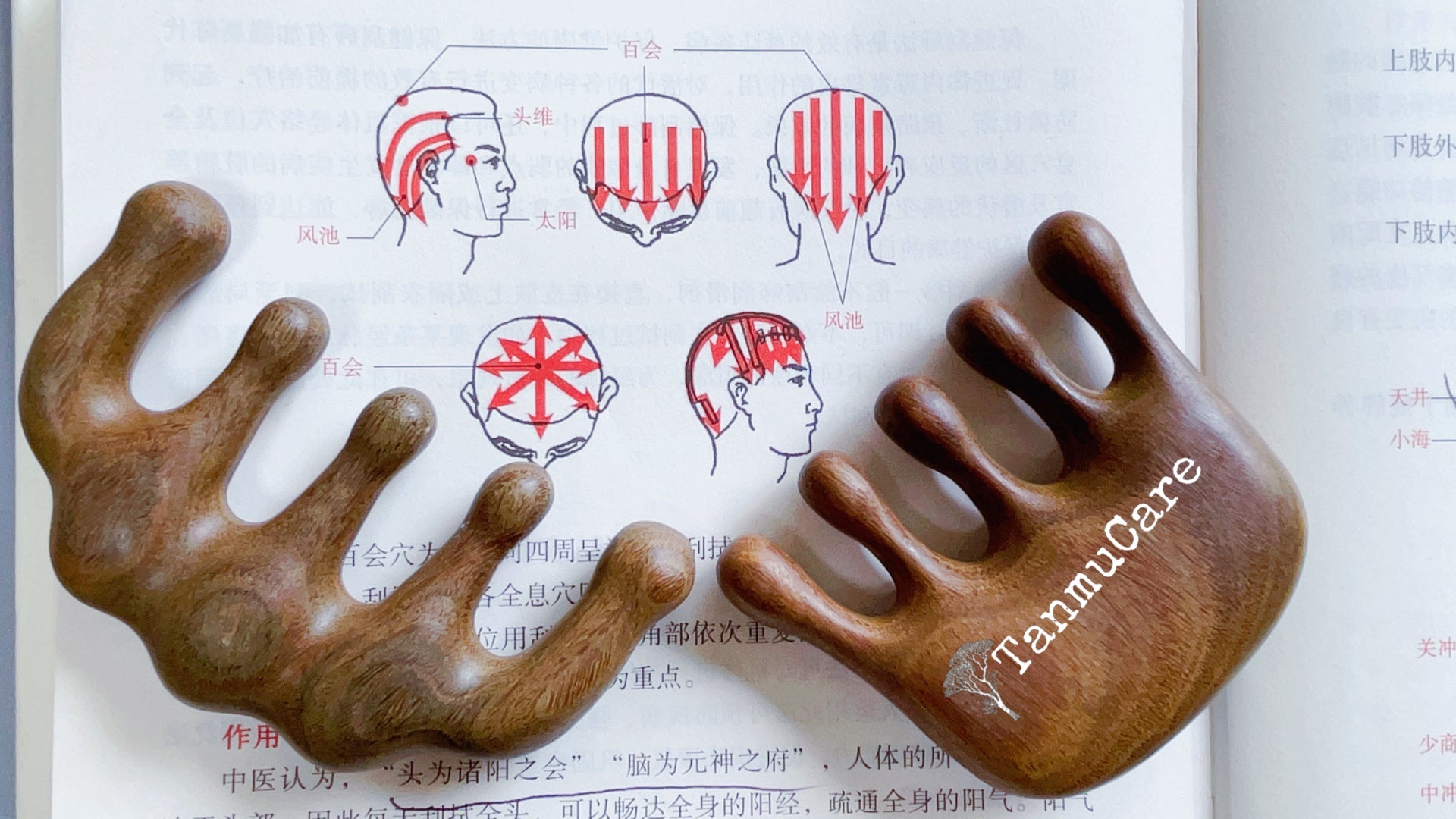No kidding, I always feel so relaxed and want to sleep right after these wonderful scalp massages and Gua Sha sessions. I hope you enjoy it as much as I do and consider adding this to your self-care routine.
For a quick tutorial, feel free to check our video here: INSTAGRAM or TikTok.
To achieve effective stimulation despite the presence of hair on the scalp, we recommend using the TanmuCare Green Sandalwood Wide-tooth Comb for Gua Sha and head massage. The comb's design, with its five teeth, is not only excellent for stimulating acupoints on the scalp and clearing meridians, but the anti-static green sandalwood material also provides hair protection, reduces frizz, and adds a subtle woody fragrance for an extra sensory relaxation experience during each scalp Gua Sha session.
Let’s dive into the step-by-step tutorials!
(Method by Chinese Gua Sha Expert Professor Zhang Xiu Qin)
Step 1) Temples:
Gently perform Gua Sha on both the left and right temples. You can use the ball head of the comb's teeth to gently press your temples, relaxing them for 30 seconds each. You may feel some soreness here. This can greatly help in relieving headaches and eye strain.
Step 2) Side of the Head:
Use the wide-tooth massage comb's side to scrape from the forehead hairline all the way back to the hairline behind your ears. Scrape each side for 1 minute. There are many acupoints on our scalp and behind our ears, and scraping the sides of our scalp like this can significantly alleviate headaches, migraines, and reduce hair loss and gray hair.
Step 3) Front and Back of the Head:
Locate the Baihui acupoint as shown in the video, which is at the crown of your head. Divide the scalp massage area into 2 parts, with the Baihui acupoint as the boundary.
Begin by performing Gua Sha on the front section, moving from the Baihui acupoint towards the hairline on the forehead, or from the hairline on the forehead towards the Baihui acupoint, scraping from left to right.
Next, move on to the back section, starting the scrape from the Baihui acupoint down to the hairline at the back of the neck, also moving from left to right.
You may experience some discomfort during your scalp Gua Sha, especially if you've just finished work or have been under a lot of stress lately. There's a saying in traditional Chinese medicine: "If it flows, it doesn't hurt; if it hurts, it doesn't flow." (通则不痛,通则不痛) So, continue scraping, and you'll definitely feel more comfortable with daily scalp massage and Gua Sha.
Step 4) Baihui Acupoint (DU 20):
Gua Sha radiates outward from the Baihui acupoint at the center. There's an important acupoint called Sishencong around the Baihui acupoint, which is excellent for improving memory, sleep quality, and relieving headaches.
Scrape areas that feel painful to relieve tension for better results, such as the Fengchi GB 20 acupoint. This acupoint greatly helps in relieving stiff neck headaches and cold symptoms. Since I am suffering from a cold, I often perform Gua Sha these areas multiple times a day.
Step 5) Advanced Technique:
Use the wide-tooth scalp massage and Gua Sha comb in a zigzag motion from front to back and from left to right to intensify the Gua Sha. Focus on relaxing the Baihui (DU 20), Fengchi (GB 20), and other acupoints.
Incorporating these methods and the use of the TanmuCare Green Sandalwood Meridian Comb into your scalp massage and Gua Sha routine can enhance the benefits and provide a soothing and aromatic experience for you and your family members.
Why are scalp massage and gua sha so vital for your health?
In traditional Chinese medicine, it is believed that "the head is the meeting place of all Yang" (头为诸阳之会)and "the brain is the residence of the original spirit."(脑为元神之府). All Yang meridians in the body converge at the head. Therefore, daily scalp massage and Gua Sha can promote the flow of Yang energy throughout the body, enhancing vitality, quickly relieving fatigue, boosting the body's immune system, and reducing the risk of colds.
From a Western medical perspective, the head is home to the central nervous system, with the brain's cortex governing language, vision, hearing, smell, taste, and the regulation of visceral functions, as well as serving as the central hub for sensory and motor functions throughout the body. The scalp corresponds to the projection area of these various neural centers. Scalp massage and Gua Sha not only directly stimulate nerve endings in the head, relax local muscle tension, and improve scalp microcirculation, but they can also enhance the functioning of the central nervous system. This can help prevent and treat conditions such as cerebral arteriosclerosis, strokes, central sensory disorders, motor disorders, neurasthenia, various types of headaches, dizziness, decreased energy, and even enhance memory and slow down the aging process.
Get your wide-tooth green sandalwood scalp massage comb NOW and join TanmuCare to enjoy relaxation and inner peace through daily scalp massage and Gua Sha!












Share:
Without gallbladder= without gallbladder meridian?
Reducing Crow's Feet and Wrinkles Around Your Eyes with Facial Gua Sha